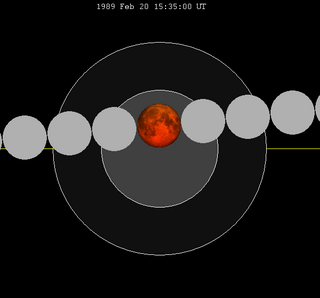
A total lunar eclipse took place on Tuesday 4 May 2004, the first of two total lunar eclipses in 2004, the second being on 28 October 2004.

A total lunar eclipse took place on Friday, February 9, 1990, the first of two lunar eclipses in 1990.

A penumbral lunar eclipse took place on Wednesday 20 November 2002, the last of three lunar eclipses in 2002.

A total lunar eclipse took place on Monday, February 20, 1989, the first of two total lunar eclipses in 1989.

A total lunar eclipse took place at 0308 UT (GMT) on Thursday, August 17, 1989, the second of two total lunar eclipses in 1989.

A total lunar eclipse will take place between Monday and Tuesday, June 25-26, 2029. A central total eclipse lasting 1 hour and 41 minutes 53 seconds will plunge the full Moon into deep darkness, as it passes right through the centre of the Earth's umbral shadow. While the visual effect of a total eclipse is variable, the Moon may be stained a deep orange or red color at maximum eclipse. It will be able to be seen from most of the Americas, Western Europe and Africa. The partial eclipse will last for 3 hours and 39 minutes 32 seconds in total.
A total lunar eclipse took place on Monday, October 28, 1985, the second of two total lunar eclipses in 1985, the first being on May 4, 1985.
A total lunar eclipse took place on Thursday, April 24, 1986, the first of two total lunar eclipses in 1986, the second being on October 17, 1986. The Moon was plunged into darkness for 1 hour, 3 minutes and 34.8 seconds, in a deep total eclipse which saw the Moon 20.217% of its diameter inside the Earth's umbral shadow. The visual effect of this depends on the state of the Earth's atmosphere, but the Moon may have been stained a deep red colour. The partial eclipse lasted for 3 hours, 18 minutes and 46.8 seconds in total. The Moon was just 1.2 days before perigee, making it 5.3% larger than average.
A total lunar eclipse took place on Friday, November 29, 1974, the second of two lunar eclipses in 1974. The Moon was plunged into darkness for 1 hour, 15 minutes and 45 seconds, in a deep total eclipse which saw the Moon 28.961% of its diameter inside the Earth's umbral shadow. The visual effect of this depends on the state of the Earth's atmosphere, but the Moon may have been stained a deep red colour. The partial eclipse lasted for 3 hours, 28 minutes and 58.7 seconds in total. The penumbral eclipse lasted for 5 hours, 33 minutes and 11.6 seconds. The partial eclipse lasted for 3 hours, 28 minutes and 58.7 seconds. The total eclipse lasted for 1 hour, 15 minutes and 45 seconds. Occurring only 3.6 days before perigee, the Moon's apparent diameter was 1.4% larger than average.

A total lunar eclipse will take place on 7-8 September 2025. The Moon will barely miss the center of the Earth's shadow. It will be the second of two total lunar eclipses. Occurring roughly 3 days before perigee, the Moon will appear larger than usual.

A penumbral lunar eclipse will take place on May 7, 2031.

A total lunar eclipse took place on Monday, May 13, 1957, the third of fourteen total lunar eclipses of Lunar Saros 130. The Moon was plunged into darkness for 1 hour and 18 minutes, in a deep total eclipse which saw the Moon 30% of its diameter inside the Earth's umbral shadow. The visual effect of this depends on the state of the Earth's atmosphere, but the Moon may have been stained a deep red colour. The partial eclipse lasted for 3 hours and 32 minutes in total.
A partial lunar eclipse took place on Sunday, April 12, 1903. This nearly total lunar eclipse of Saros cycle 130 preceded the first total eclipse on April 22, 1921. The Moon was almost covered by the Earth's shadow in a very deep partial eclipse, which lasted 3 hours and 17 minutes, with 96.77% of the Moon in shadow at maximum eclipse.

A total lunar eclipse will take place on July 29, 2083. The Moon will be plunged into darkness for 1 hour and 30 minutes, in a deep total eclipse which will see the Moon 48.3% of its diameter inside the Earth's umbral shadow. The visual effect of this depends on the state of the Earth's atmosphere, but the Moon may be stained a deep red colour. The partial eclipse will last for 3 hours and 33 minutes in total.
A partial lunar eclipse took place on Thursday, March 12, 1914.

A total lunar eclipse took place on Wednesday, October 18, 1967, the second of two total lunar eclipses in 1967, the first being on April 24, 1967.

A partial lunar eclipse took place on Tuesday, March 24, 1959.

A partial lunar eclipse took place on Thursday, May 24, 1956. It was the first eclipse of the last partial set in Saros series 120.

A total lunar eclipse took place on Thursday, January 29, 1953. The Moon passed through the center of the Earth's shadow.

A total lunar eclipse will take place on September 19, 2043.









































































